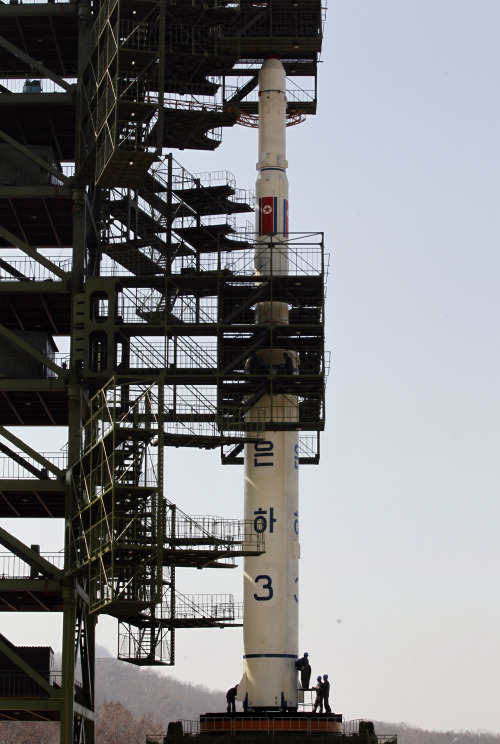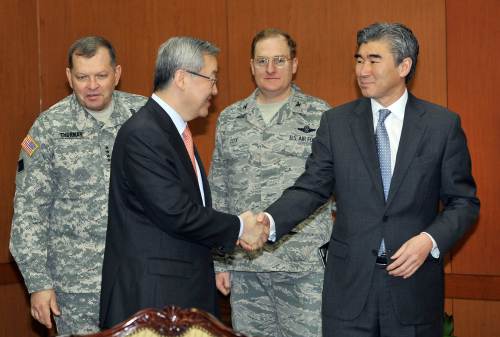World condemns North Korea's failed rocket launch
By Korea HeraldPublished : April 13, 2012 - 20:10

The South Korean government strongly condemned Pyongyang’s rocket launch as it scrambled to put in place emergency measures on Friday.
“North Korea’s launch is a clear violation of the U.N. Security Council Resolution 1874 that bans any launches using ballistic missile technologies, and a provocative act that threatens the peace and safety of the Korean Peninsula and Northeast Asia,” Minister of Foreign Affairs Kim Sung-hwan said.
“The government strongly denounces North Korea’s new leadership’s decision to push ahead despite the international community’s unanimous calls to cancel the launch. North Korea will have to take due responsibility.”
Kim also said that Seoul is drawing up a comprehensive plan for responding to further provocations from North Korea, and to nuclear and missile threats.
“North Korea’s launch is a clear violation of the U.N. Security Council Resolution 1874 that bans any launches using ballistic missile technologies, and a provocative act that threatens the peace and safety of the Korean Peninsula and Northeast Asia,” Minister of Foreign Affairs Kim Sung-hwan said.
“The government strongly denounces North Korea’s new leadership’s decision to push ahead despite the international community’s unanimous calls to cancel the launch. North Korea will have to take due responsibility.”
Kim also said that Seoul is drawing up a comprehensive plan for responding to further provocations from North Korea, and to nuclear and missile threats.

At 7:39 a.m. on Friday, North Korea launched a long-range rocket carrying a small satellite from the Dongchang-ri launch facility in North Pyongan Province.
The rocket, however, failed within two minutes of the launch, and broke up into about 20 pieces before falling into the West Sea between 100 kilometers and 150 kilometers west of Gunsan, North Jeolla Province.
Soon after the rocket was detected by the South Korean destroyer Sejong the Great, various government organs called emergency meetings.
At 9 a.m. President Lee Myung-bak called a meeting of security and foreign affairs ministers, while the military held a meeting of the emergency management committee.
South Korean and U.S. militaries also met to discuss the developments.
“This is a provocation not only to South Korea but to the international community. It is also a military threat to South Korea. I think that there needs to be appropriate international-level restraints,” Minister of National Defense Kim Kwan-jin said at a meeting with U.S. officials including U.S. Forces Korea commander General James Thurman.
Other government organizations without direct security responsibilities also convened meetings and introduced measures in response to the launch.
The Bank of Korea began operating a 24-hour emergency monitoring system headed by Senior Deputy Governor Park Won-shik, while the Ministry of Strategy and Finance called a meeting of economy and finance-related ministries including the Ministry of Knowledge Economy, Bank of Korea and the Financial Services Commission.
Finance Minister Bahk Jae-wan said that the ministries will analyze the economic impact of the launch and that they will respond “according to the prepared manual.”
As a pan-government effort to handle the situation went under way, the military made preparations to retrieve the rocket’s debris. However, as debris fell over a large area, it is unclear when the retrieval process will be completed.
“If the rocket parts are floating, they will be retrieved immediately, but if they have sunk, it will require time. We do not know where the debris are, and as the area is large it’s hard to predict when they will be retrieved,” Defense Ministry spokesman Kim Min-seok said. The rocket is said to have broken up into 20 pieces before falling into the sea.
Kim added that as the possibility of the pieces breaking into smaller parts upon impact cannot be ruled out.
The military is also closely watching North Korea for possible further developments.
“The surveillance assets of Korean and the U.S. forces have been deployed to closely monitor North Korea’s military movements,” Major General Shin Won-shik said.
“In addition, we will closely watch for (possible) North Korean military provocations, additional missile launches and nuclear tests, and maintain firm readiness posture through close Korea-U.S. cooperation.”
Pyongyang had warned of a third nuclear test should other countries interfere with the launch of the rocket through a Japan-based pro-Pyongyang newspaper.
In an article published on April 5, the paper said that the U.S. appears to want “the clock to turn back to after April (2009)” saying that North Korea conducted the second nuclear test in May 2009 as a “self-protective measure in response to U.N. Security Council’s sanctions.” In April of that year, the U.N. Security Council agreed on sanctions in response to the launch of the Kwangmyongsong-2 long range rocket in April 2009.
By Choi He-suk (cheesuk@heraldcorp.com)
-
Articles by Korea Herald







![[KH Explains] Hyundai's full hybrid edge to pay off amid slow transition to pure EVs](http://res.heraldm.com/phpwas/restmb_idxmake.php?idx=644&simg=/content/image/2024/04/18/20240418050645_0.jpg&u=20240419100350)







![[From the Scene] Monks, Buddhists hail return of remains of Buddhas](http://res.heraldm.com/phpwas/restmb_idxmake.php?idx=652&simg=/content/image/2024/04/19/20240419050617_0.jpg&u=20240419175937)

![[KH Explains] Hyundai's full hybrid edge to pay off amid slow transition to pure EVs](http://res.heraldm.com/phpwas/restmb_idxmake.php?idx=652&simg=/content/image/2024/04/18/20240418050645_0.jpg&u=20240419100350)

![[Today’s K-pop] Illit drops debut single remix](http://res.heraldm.com/phpwas/restmb_idxmake.php?idx=642&simg=/content/image/2024/04/19/20240419050612_0.jpg&u=)